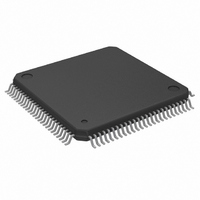MC68EC020AA25 Freescale Semiconductor, MC68EC020AA25 Datasheet - Page 34

MC68EC020AA25
Manufacturer Part Number
MC68EC020AA25
Description
IC MPU 32BIT 25MHZ 100-QFP
Manufacturer
Freescale Semiconductor
Datasheet
1.MC68EC020AA16.pdf
(306 pages)
Specifications of MC68EC020AA25
Processor Type
M680x0 32-Bit
Speed
25MHz
Voltage
5V
Mounting Type
Surface Mount
Package / Case
100-QFP
Family Name
M68000
Device Core
ColdFire
Device Core Size
32b
Frequency (max)
25MHz
Instruction Set Architecture
RISC
Supply Voltage 1 (typ)
5V
Operating Supply Voltage (max)
5.25V
Operating Supply Voltage (min)
4.75V
Operating Temp Range
0C to 70C
Operating Temperature Classification
Commercial
Mounting
Surface Mount
Pin Count
100
Package Type
PQFP
Lead Free Status / RoHS Status
Lead free / RoHS Compliant
Features
-
Lead Free Status / Rohs Status
RoHS Compliant part
Electrostatic Device
Available stocks
Company
Part Number
Manufacturer
Quantity
Price
Company:
Part Number:
MC68EC020AA25
Manufacturer:
Freescale Semiconductor
Quantity:
10 000
Company:
Part Number:
MC68EC020AA25R
Manufacturer:
Freescale Semiconductor
Quantity:
10 000
- Current page: 34 of 306
- Download datasheet (2Mb)
2.3 EXCEPTION PROCESSING
An exception is defined as a special condition that preempts normal processing. Both
internal and external conditions can cause exceptions. External conditions that cause
exceptions are interrupts from external devices, bus errors, coprocessor-detected errors,
and reset. Instructions, address errors, tracing, and breakpoints are internal conditions
that cause exceptions. The TRAP, TRAPcc, TRAPV, cpTRAPcc, CHK, CHK2, RTE,
BKPT, CALLM, RTM, cp RESTORE, DIVS and DIVU instructions can generate exceptions
as part of their normal execution. In addition, illegal instructions, privilege violations, and
coprocessor protocol violations cause exceptions.
Exception processing, which is the transition from the normal processing of a program to
the processing required for the exception condition, involves the exception vector table
and an exception stack frame. The following paragraphs describe the exception vectors
and a generalized exception stack frame. Exception processing is discussed in detail in
Section 6 Exception Processing. Coprocessor-detected exceptions are discussed in
detail in Section 7 Coprocessor Interface Description.
2.3.1 Exception Vectors
The VBR contains the base address of the 1024-byte exception vector table, which
consists of 256 exception vectors. Exception vectors contain the memory addresses of
routines that begin execution at the completion of exception processing. These routines
perform a series of operations appropriate for the corresponding exceptions. Because the
exception vectors contain memory addresses, each consists of one long word, except for
the reset vector. The reset vector consists of two long words: the address used to initialize
the ISP and the address used to initialize the PC.
The address of an exception vector is derived from an 8-bit vector number and the VBR.
The vector numbers for some exceptions are obtained from an external device; others are
supplied automatically by the processor. The processor multiplies the vector number by
four to calculate the vector offset, which it adds to the VBR. The sum is the memory
address of the vector. All exception vectors are located in supervisor data space, except
the reset vector, which is located in supervisor program space. Only the initial reset vector
is fixed in the processor's memory map; once initialization is complete, there are no fixed
assignments. Since the VBR provides the base address of the vector table, the vector
table can be located anywhere in memory; it can even be dynamically relocated for each
task that is executed by an operating system. Details of exception processing are provided
in Section 6 Exception Processing, and Table 6-1 lists the exception vector
assignments.
MOTOROLA
M68020 USER’S MANUAL
2- 5
Related parts for MC68EC020AA25
Image
Part Number
Description
Manufacturer
Datasheet
Request
R
Part Number:
Description:
Manufacturer:
Freescale Semiconductor, Inc
Datasheet:
Part Number:
Description:
Manufacturer:
Freescale Semiconductor, Inc
Datasheet:
Part Number:
Description:
Manufacturer:
Freescale Semiconductor, Inc
Datasheet:
Part Number:
Description:
Manufacturer:
Freescale Semiconductor, Inc
Datasheet:
Part Number:
Description:
Manufacturer:
Freescale Semiconductor, Inc
Datasheet:
Part Number:
Description:
Manufacturer:
Freescale Semiconductor, Inc
Datasheet:
Part Number:
Description:
Manufacturer:
Freescale Semiconductor, Inc
Datasheet:
Part Number:
Description:
Manufacturer:
Freescale Semiconductor, Inc
Datasheet:
Part Number:
Description:
Manufacturer:
Freescale Semiconductor, Inc
Datasheet:
Part Number:
Description:
Manufacturer:
Freescale Semiconductor, Inc
Datasheet:
Part Number:
Description:
Manufacturer:
Freescale Semiconductor, Inc
Datasheet:
Part Number:
Description:
Manufacturer:
Freescale Semiconductor, Inc
Datasheet:
Part Number:
Description:
Manufacturer:
Freescale Semiconductor, Inc
Datasheet:
Part Number:
Description:
Manufacturer:
Freescale Semiconductor, Inc
Datasheet:
Part Number:
Description:
Manufacturer:
Freescale Semiconductor, Inc
Datasheet:











